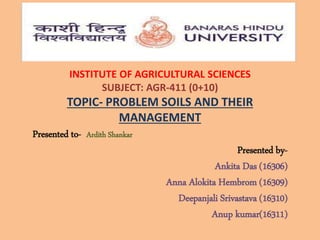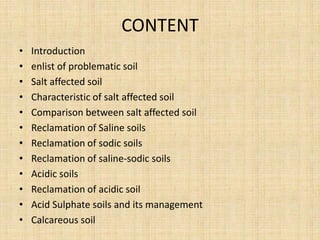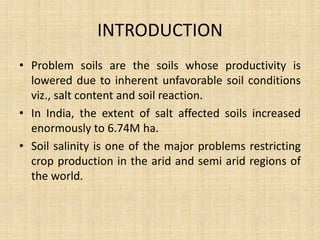The document discusses various types of problematic soils, including saline, sodic, and acidic soils, detailing their characteristics and reclamation methods. It highlights the prevalence of salt-affected soils in India, the factors contributing to their condition, and approaches for improving soil health through cultural, biological, chemical, and irrigation management practices. Additionally, it emphasizes the need for careful selection of crops to ensure resilience against soil salinity and acidity.














![IV.Chemical method
Amendments:
• Gypsum: When gypsum is applied to ameliorate salt affected soils,
the following reaction will take place and loss of exchangeable
sodium occurs and calcium will take place of sodium on the exchange
complex. Gypsum reacts with both Na2CO3 and the sodium adsorbed
sodium as follows:
Na2CO3 + CaSO4↔ CaCO3 +Na2CSO4↓
[Clay]Na + CaSO4↔ Ca[Clay + Na2SO4↓
• Sulphur:
2S +3O2 = 2SO3
SO3 + H2O = H2SO4
H2SO4 + Na2CO3↔ CO2 + H2O + Na2SO4↓](https://image.slidesharecdn.com/agronomyppt-191111033222/85/PROBLEM-SOILS-AND-THEIR-MANAGEMENT-15-320.jpg)



















![Degraded alkali soils
Charecteristics-
1) Formed in highly irrigated /areas with
extensive leaching.
2) Top soil – Acidic, Sub-surface soil- Sodic(
black in colour)
Formation-
Clay]Na+ + H2O = Clay]H+ + NaOH (acidic)
NaOH + CO2 =Na2CO3 + H2O (basic)](https://image.slidesharecdn.com/agronomyppt-191111033222/85/PROBLEM-SOILS-AND-THEIR-MANAGEMENT-35-320.jpg)
